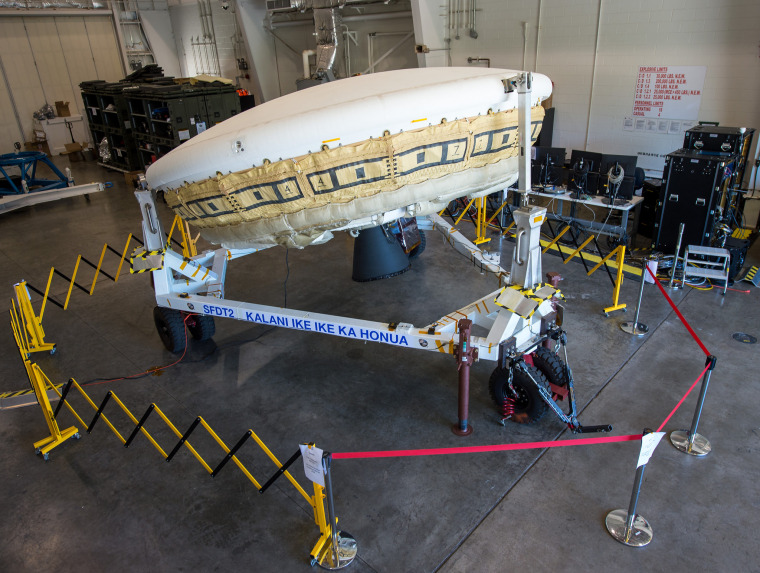NASA has had to postpone the balloon-borne launch of its rocket-powered "flying saucer" from a test range in Hawaii repeatedly, due to weather concerns.
The saucer-shaped Low Density Supersonic Decelerator, or LDSD, is designed to demonstrate technologies that are likely to come into play for delivering heavy payloads to Mars. The odd-looking craft is equipped with an inflatable, doughnut-shaped shield as well as a super-strong parachute that should slow the LDSD down from supersonic speeds during descent.

The scenario for the test calls for a high-altitude balloon to carry the LDSD aloft from the U.S. Navy's Pacific Missile Range Facility on the Hawaiian island of Kauai. The LDSD would be dropped from a height of 120,000 feet, and then fire its rocket engine to go even higher — 180,000 feet.
On the way up, the LDSD would hit a top speed of Mach 4, or four times the speed of sound. On the way down, the doughnut-shaped cushion — known as the Supersonic Inflatable Aerodynamic Decelerator, or SIAD — would be inflated to a diameter of 20 feet (6 meters). The SIAD is designed so that atmospheric drag slows the craft down from Mach 3 to about Mach 2.4.
The test parachute would then unfurl to slow the descent even more, so that the LDSD platform falls gently into the Pacific Ocean for recovery.
The LDSD's first flight test took place a year ago and successfully tested the inflatable drag shield. The parachute, however, tore itself apart — resulting in a harder-than-expected splashdown.
Related: Flying Saucer Videos Show What Worked (and What Didn't)
Since then, the parachute has been redesigned to be "much stronger, much more robust," said Ian Clark, principal investigator for the LDSD effort at JPL.
This year's follow-up test could have taken place as early as Tuesday; however, NASA said the waves in the Pacific were too high to ensure the safety of the crew members who would have to recover the LDSD after splashdown. The waves settled down later in the week, but then winds became a concern.
On Friday, NASA said it wouldn't try to test the LDSD during the weekend, "due to low-altitude wind conditions that would prevent the launch of the balloon." The team said it would evaluate the conditions for a potential launch on Monday.
This month's launch window is open until June 12, and another window will come up in July, said Mark Adler, the LDSD project manager.
Adler said $230 million has been budgeted over three years for developing the LDSD system. NASA says such drag devices should be capable of delivering 2- to 3-ton payloads safely to the Martian surface.
Current technologies limit NASA's Mars payloads to about a ton. That worked out fine for landing the Curiosity rover in 2012, and it'll also work for the rover that NASA plans to launch in 2020. But it's not good enough for landing the equipment that would be required for future human missions to the Red Planet, or for landing high-value payloads in high-elevation regions of Mars. Those situations require the kinds of technologies that are being tested in Hawaii.
